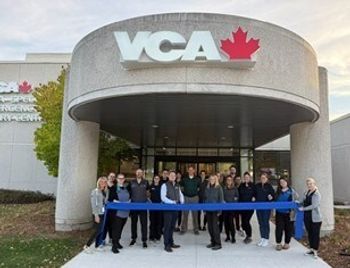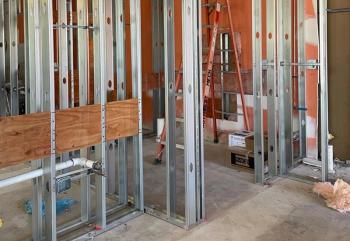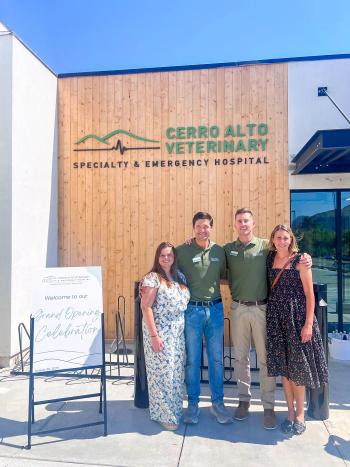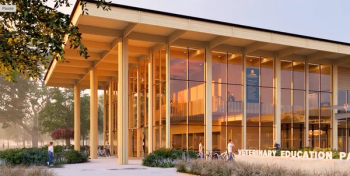
Re-creating the Northwoods
Dr. Richard Piepgras started working at Lakeland Veterinary Hospital his senior year of high school. During the summer visit to his family's vacation cabin, he worked in the kennel, mowed the lawn, and even assisted in surgery. "I've been here a long time," says the 1967 Iowa State graduate, chuckling. Little did he know that he would someday own the practice-and build an award-winning facility to house it.
By Carolyn Chapman,
special assignments editor
Dr. Richard Piepgras started working at Lakeland Veterinary Hospital his senior year of high school. During the summer visit to his family's vacation cabin, he worked in the kennel, mowed the lawn, and even assisted in surgery. "I've been here a long time," says the 1967 Iowa State graduate, chuckling. Little did he know that he would someday own the practice-and build an award-winning facility to house it.
Judges of the Veterinary Economics Hospital Design Competition found the rustic exterior fitting for Minnesota's north-central lake country. "This hospital uses warm, inviting colors that won't look dated in a few years," remarked one competition judge, while another praised the separate dental and special-procedures room.
Highway interference
Dr. Piepgras purchased Lakeland Veterinary Hospital in 1971 from the retiring owner, who'd started the hospital 11 years earlier. The original 2,300-square-foot facility accommodated a mixed animal practice, which meant the building layout was less than ideal when it came to serving the strictly small animal clientele Dr. Piepgras developed as the new owner.
Ten years later, Dr. Piepgras remodeled the structure to better suit his needs, adding 2,300 square feet to serve as the main facility and using the original space for boarding and grooming. Then in 1998, an upcoming highway expansion forced Dr. Piepgras to re-evaluate his location and his building.
The city planned to widen the road in front of the hospital and add a median-a move that would cut off direct access to the hospital. "The new configuration would've required clients to drive past the hospital and turn around," Dr. Piepgras explains.
After talking it over with his family and staff members, Dr. Piepgras decided the road construction was the catalyst he'd been waiting for to build his ideal hospital. For years, he'd kept an eye on a plum building site one mile north of his existing hospital. "We could see the land from the highway, but because the plot sits on an access road, we didn't have to pay the high prices highway frontage sites command," he says.
Fortune smiled again when a representative from a local bank approached Dr. Piepgras with an interesting offer. In a 1031 exchange, the bank purchased the new building site and paid for the construction. When the project was complete, Dr. Piepgras and the bank swapped the original building for the new one. After the exchange, Dr. Piepgras worked with his regular bank to finance the remaining cost of the new facility.
Dr. Piepgras took hold of the design reins immediately, drawing various designs based on his experiences in the old facility and plans in Veterinary Economics' Portfolio of Award-Winning Floor Plans. With these ideas in hand, he hired local architect and contractor Brooke Silvernail of Nor-Son Inc., the company he'd hired previously to build another hospital he owns in the area.
Walking the site daily allowed Dr. Piepgras to identify problems and make minor alterations. For example, on one walk-through he discovered that plumbing to the treatment tables was misaligned. And when the hospital was nearly complete, Dr. Piepgras added wainscoting to the reception area. "Of course, the change increased costs, but this detail helps make the atmosphere in the reception area warmer and more inviting," he says.
Dr. Piepgras says that it's important to plan for such cost overruns to keep the project running smoothly. "You'll never think of everything, so if you're planning to build, add a cushion in your financing package to cover unexpected costs," he says.
A rustic attraction
Dr. Piepgras stipulated a rugged look for the exterior to blend with the rustic design of summer cabins in the area. A mix of pine log-cabin siding, varied roof angles, and cultured stone contributes to the effect. "We're proud of the Northwoods look we created," Silvernail says.
Obviously, the design needed to take into account the hot Minnesota summers and frigid winters. "We experience temperatures that drop to 30 degrees below zero in the winter and sometimes hit 90 degrees in the summer," Dr. Piepgras says. Heated sidewalks, an idea he borrowed from another Veterinary Economics Merit Award winner, minimize the snow and salt that clients and pets track into the hospital. And airlock vestibules keep winter winds at bay.
To help maintain a constant temperature inside, a heat engineering firm designed the environmental systems, and Dr. Piepgras chose sealed windows for efficiency. Silvernail says higher-than-normal air exchanges bring fresh air into the hospital.
When clients enter the facility, team members greet them in a spacious reception area. A built-in floor mat with drains below helps keep floors clean when it snows during the winter. Slip-resistant quarry tile covers the floors in the reception area, exam rooms, and the pharmacy and lab. Nestled between entry and exit doors, the reception counter helps guide traffic flow.
Across from the counter, five exam rooms span the building. Dr. Piepgras plumbed the closet in the doctors' office, located directly north of the exam rooms, so he could convert it into a sixth exam room if necessary.
The pharmacy and lab sit behind the exam rooms and serve as a bridge to the treatment area and two surgery suites. And a separate dental procedures room occupies the north corner of the working area. Dr. Piepgras purposely dedicated considerable space to this room and excluded windows in hopes of adding additional specialty services. "We already use that room for ultrasound and some ophthalmologic procedures," he says.
The isolation ward sits near the center of the working area, across from the dental suite and near the treatment area. And the boarding and grooming facilities take up the remainder of the first floor. Although Dr. Piepgras came very close to eliminating these ancillary services, he's glad that staff members encouraged him to keep them. "Clients appreciate all of these extras," he says. The top floor features a large conference room and a small apartment to house a future intern.
Dr. Piepgras' only complaint with the finished facility: "Spraying the high ceiling in the boarding area wasn't enough to control the noise of dogs barking, which bounces off the waterproof Formica panels," he says. "The noise doesn't reach the front of the hospital, but it still irritates staff members." He plans to address the problem soon.
Looking back-and ahead
Dr. Piepgras remembers a time when the land around the practice held nothing but pasture grass. "We had virtually no competition then," he says. Now, the area teems with large retail stores, and more veterinarians have flocked to the popular vacation destination. While the stable population in Baxter, Minn., numbers about 55,000, summer visitors push the total to about 100,000.
Dr. Piepgras' new facility is built to manage that summertime boom, and he says the practice is a legacy he's proud of. As he approaches retirement, he plans to leave the hospital in the capable hands of his daughter, Dr. Deborah Piepgras; her fianc, Dr. Matthew Eberts; and Associate Dr. Anne Haecker. "I believe this building conveys the high standard of medicine we practice," he says. "I'm proud of this place."
Carolyn Chapman, a former Veterinary Economics associate editor, is a freelance writer in Liberty, Mo.
Newsletter
From exam room tips to practice management insights, get trusted veterinary news delivered straight to your inbox—subscribe to dvm360.






